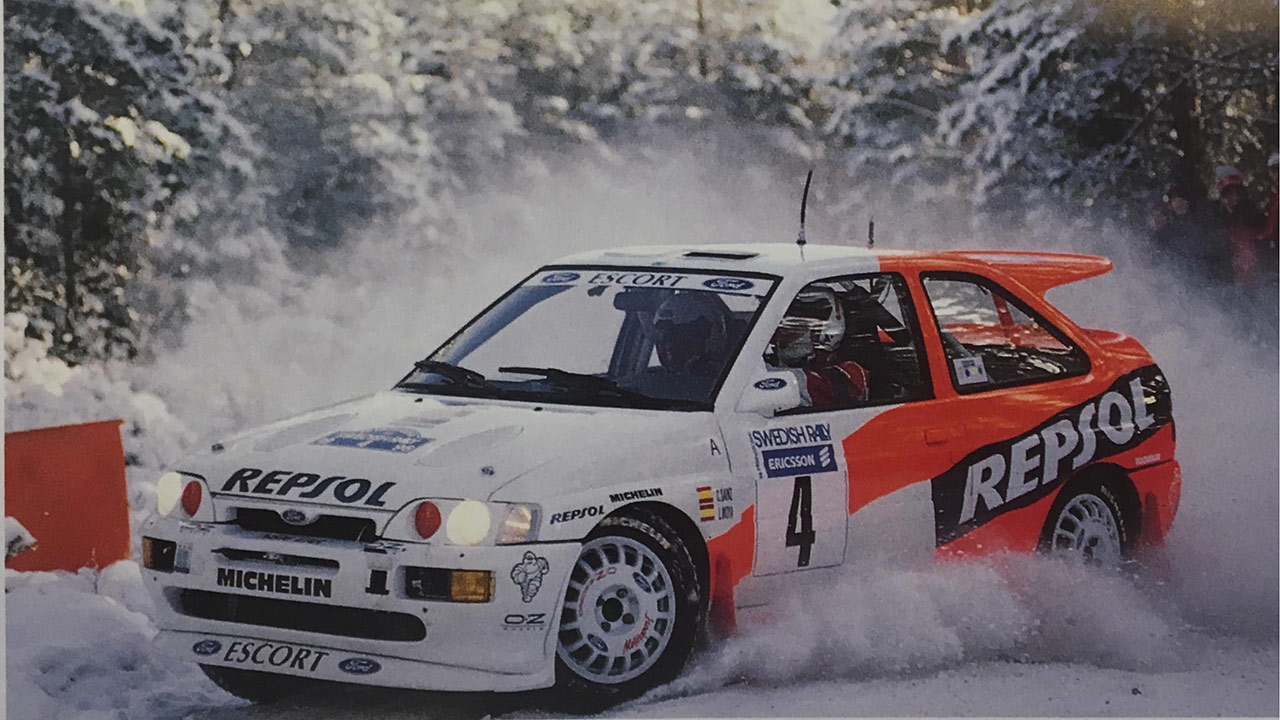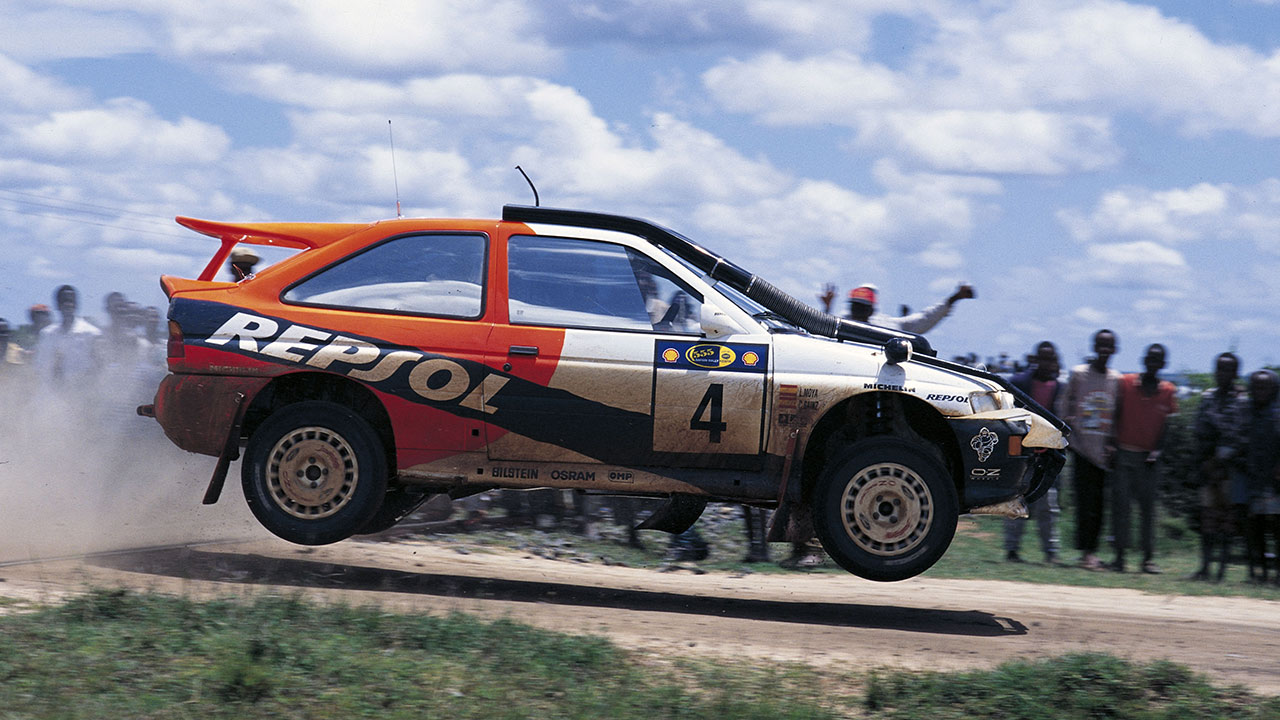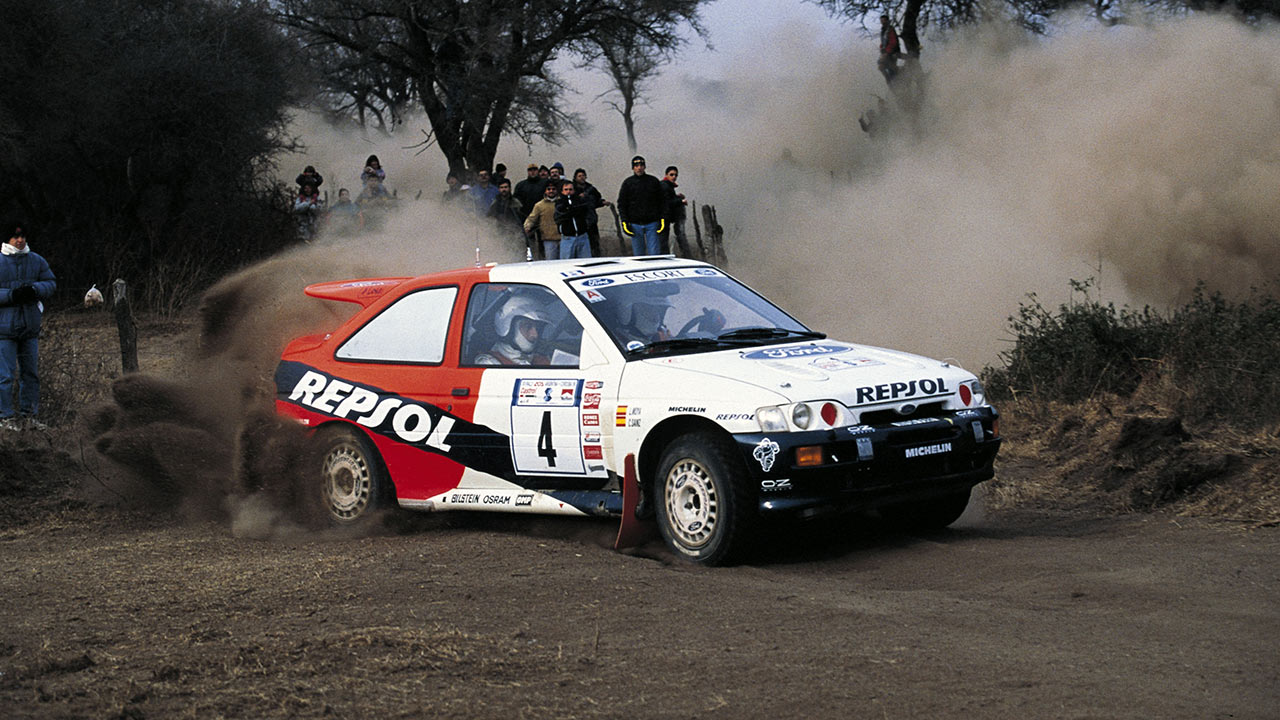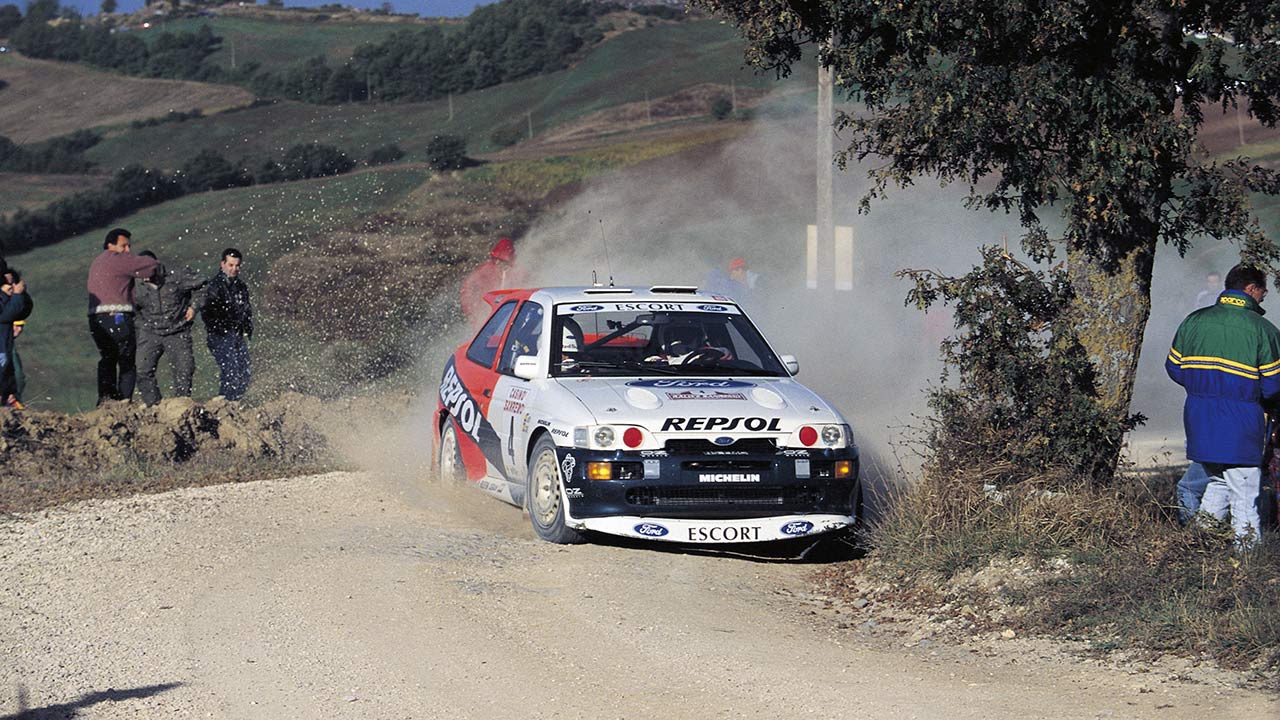
De Leyenda
1995 World Rally Championship: an exciting year for Carlos Sainz
6 months ago
The car that Sainz would drive would be the Ford Escort RS Cosworth, a vehicle that had already demonstrated its high competitiveness years ago, winning rallies in Montecarlo, Corsica, and the 1000 lakes, amongst others, but which in recent times hadn’t been evolving at the same level as its rival cars. Its last victory came in 1994, which suggested that a major upgrade of its capabilities would be necessary.
Carlos Sainz would have to start from scratch again and develop a car to be competitive against the Mitsubishi Lancer Evo III and the Subaru Impreza 555, which was not an easy task and not within the reach of many, especially taking into account two of the drivers that he would face: Tommi Mäkinen and his teammate from the last two seasons, Colin McRae.
The car, as was to be expected, was mounted with a two-litre turbocharged engine and gave a power output of around 300 horsepower. This was transmitted through a manual six-speed gearbox and a total traction system equipped with front and central differentials with electro-hydraulic control, and a Torsen or disc rear depending on the terrain where the car was going to race. The handbrake disconnected the central differential so that it wasn’t necessary apply the clutch when using it when rounding curves. However, after the tests carried out at the start of the year, Carlos now saw that it could be improved, making several changes to the suspension and differentials.
The season would have nine rounds, all of them for points. Some changes in the rules meant that, now, the mechanical services were more limited, forcing the driver and co-driver to act as mechanics between special stages to fix problems with the car.
Sainz would see François Delecour, Stig Blomqvist, Gwyndaf Evans, and Bruno Thiry as teammates, all of them having spells at the team throughout the year.
The year started and for the first time since 1973, Montecarlo wouldn’t be a points scoring rally for the World Rally Championship, although it would be for the 2-Litre World Rally Cup, where Repsol also participated with the Ibiza Kit Car, and whose title would be won in extremis that year.
Rally Sweden
The first test of fire was Rally Sweden. A 490 km round, developed on tracks of snow and ice that did not raise much hope for the first real contact with the Ford Escort, both to see if the changes made during the tests would have an effect, and because of the presence of the local drivers, experts on this type of terrain.
However, it didn’t take long for the surprise. On the first day, on the eighth special stage (the longest with 44.6 km), Sainz got the win. The first day ended with Sainz in third position and just 14 seconds off Mäkinen and eight off Kankkunen.


Things improved on the second day, achieving the best times in two of the special stages and placing Carlos in second position, chasing the Mitsubishi Lancer Evo III of Tommi Mäkinen, who only had a 15 second advantage. However, it was so even that on the 21st special stage, Sainz shared the victory with four other drivers, with all of them clocking the same time, a practically unthinkable situation due to the terrain of the rally and also because it was a night stage.
There were only five special stages on the third day. Sainz and Moya attacked from the off and started to cut time on the leader, but a malfunction in the central differential ruined the good pace that they were setting, and at the end of the day, they had to make do with an encouraging second place, 23 seconds behind Mäkinen.
Safari Rally
Leaving behind the freezing sub-zero temperatures, the World Rally Championship travelled to Africa for the second round, where the Safari Rally awaited in Kenya. The special stage, known for its hardness and length, was 1784 km that year on gravel, a distance that ended up getting reduced by more than 290 km because of the cancellation of some special stages due to downpours that had left some of the areas of the terrain practically impassable.
Like in previous years, the cars used in the Rally Safari were vehicles with a totally different configuration to the one in any other World Rally Championship round. Additional protections, improved cooling, bigger fuel tanks, and suspension settings with long travel were installed.
Despite everything, the little experience from the team in this tough round took its toll on the car, suffering suspension problems during the first day which ended with our side fifth in the table. After an intense service, they managed to return to the race during the second day applying an emergency repair although, due to the broken terrain and in spite of not forcing the mechanics, it all ended with Sainz and Moya pulling out.


Rally of Indonesia
After the fiasco in Kenya, the World Championship travelled to Asia for the Rally of Indonesia, where 452 kilometres of gravel and slippery mud tracks awaited the participants.
It was the first time that Sainz and Moya took part in this rally, so the idea was to continue gaining experience with the car and work on constant improvements.
Things started to get ugly in the middle of the first day, with some problems in the gearbox with the third and fourth gear, that jumped and ended up causing a crash off the track which, fortunately, had no consequences for the drivers. They ended the first day in fourth position, three minutes and 29 seconds off McRae who had gone all out in his fight against Mäkinen.
The second day started with several surprises. Firstly, victory in the first special stage with the same time as McRae indicated that things looked like they could even out with his rivals. The second was Tommi Mäkinen pulling out, who in his attempt to reach Colin McRae, crashed off the track, breaking the radiator and causing the engine of his Lancer EVO III to break down, saying goodbye to the rally. On the 14th special stage, and despite the bad conditions caused by the rain, Carlos managed the victory and was now second in the rankings. Close to the end of the day, Sainz crashed off track which made him lose some time and he ended the day in third position overall, four minutes and 17 seconds off McRae and less than a minute from Kankkunen.
The third day was also full of surprises. All the drivers came out attacking, but it was Sainz who won the first special stage. Piero Liatti then started to string together special stage wins and McRae, who saw his lead in danger, was under pressure and his car overturned which destroyed it and his chances of continuing. Carlos Sainz continued pressuring and trying to keep his pursuers at bay and, now at the 24th special stage, was leading and ended the round with an unexpected victory, 23 seconds ahead of Liatti and more than a minute ahead of Kankkunen.
Acropolis Rally
With a good result on the board, Carlos Sainz and Luis Moya now travelled for the next round in the World Rally Championship in Greece. It was the turn of the spectacular Acropolis Rally, which on this occasion would consist of 21 special stages on gravel, with a total of 454 km.
This year the organisation had changed some special stages, and some of them were completely new. The toughness of the terrain, the new areas, and the lack of performance from Ford against Mitsubishi and Subaru, explain the fourth place finish on day one, one minute and 49 seconds behind McRae. However, Carlos Sainz and Luis Moya were awarded a special stage victory.


The second day promised to be tougher yet, but Carlos’ hands and some settings in the car, especially in terms of weight reduction, allowed them to achieve two special stage wins and close the gap on the leaders, ending in third position, one minute and 34 seconds behind.
Almost all the drivers started to suffer tyre problems on the third day which, due to the new regulations with less services, sometimes forced them to spend two or three special stages with the same tyres and, due to the state of the tracks, the tyres ended up destroyed, forcing the drivers to notably lower the pace. The final result was satisfactory, with a third place finish just less than four minutes behind McRae, who got the win on this occasion.
Rally Argentina
It was time to change continents again, this time travelling to South America to race the Rally Argentina. The event, characterised for its fast stages, wasn’t unknown for Carlos, who had managed to win and achieve various podium finishes there in previous years. The 1996 edition would be 516 kilometres timed on gravel tracks.
The day started, which would be quite long, with 13 special stages. With new suspension settings, but without the engine improvements that were expected from Ford, Carlos Sainz came out attacking, and despite various mechanical problems, managed 4 special stage victories. The day ended with a fourth place finish just over two minutes from Mäkinen, who was flying, and the pulling out of McRae after his car overturned.


The second day, which was again long and with one of the longest special stages in the World Rally Championship, served to demonstrate that the improvements to the car were having the desired effect and, despite some problems, Carlos Sainz managed six special stage wins and third position overall. He was also able cut time on the leader, coming in just over one and a half minutes behind.
There were only five special stages on the third day. Flaws in the organisation of a stage meant a problem for some drivers who took the wrong path, but in the end and after pressuring all that he could, Carlos ended the day in second position and was 13 points from Tommi Mäkinen in the World Championship rankings.
1000 Lakes Rally
The World Championship returned to Europe and it was time for one of the most acclaimed and spectacular rallies: the 1000 Lakes Rally or Rally Finland. 478 kilometres of fast gravel tracks between woods, with many jumps and spectacular settings. Ford brought an engine modification for this occasion, with improved power delivery in the middle area.
The rally started with difficulties for Sainz, who had problems with a turbocharger leak and lost precious time on the first special stage. Sainz applied pressure on the complicated Finnish tracks, knowing that any error could be costly. An example was Colin McRae, who overturned again and had to retire from the race. Carlos demonstrated his great steering ending the final special stage without hydraulics in the shock absorber, securing an eighth place finish on the day, three minutes from top.


The second day started somewhat better. Sainz and Moya gave it their all to try and recover some time, but the competition was brutal and Rally Finland is one of the most complicated to try and catch up with opponents. Even so, Carlos managed to rise to sixth place overall, but he lost a few more seconds on Mäkinen, who, as a good home driver, was becoming unreachable.
The third day was expected to be complicated, as out of the six special stages, two of them were completely new for Sainz, and were also raced in both directions. Unfortunately, just a few kilometres before finishing the final special stage, the Ford Escort gearbox said enough is enough and Carlos and Luis had no chance of finishing the round in a possible podium position, also giving up many chances of winning the World Championship.
Rally Australia
The World Rally Championship now travelled to the other side of the world for the Rally Australia, with 475 kilometres of difficult large gravel that was also complicated because of the rainfall in the previous days.
Sainz started the first day by winning the first two special stages and repeating the win in the fifth. Mäkinen was again the man to beat and Carlos tried to limit the loss of time with the Finnish driver through precise driving and thanks to the good performance of the car. The day ended with Carlos in second place, 37 seconds behind Tommi.
The rain stole the show on the second day, leaving tracks in some very slippery conditions and forcing the retrospective cancellation of some special stages, including one that had to cross a river just 200 metres from the end, and in which both Carlos and other drivers saw their cars shut down due to the high water level. Thanks to the cancellation of that stage, Carlos was able to get the car serviced and solve the problems, continuing the race and ending the day in third place, one minute and 53 seconds behind.
It was time for the third day of this very complicated rally and Sainz went all out to try and get second spot as, if Mäkinen won, that second place was the only thing that would avoid the Finnish driver being mathematically proclaimed World Champion. Carlos flew down the slippery tracks, achieving victory in six of the eight special stages and keeping the hope of overtaking Eriksson alive but, in the end, he was four seconds from second position, giving the World Championship to Mäkinen and ending the rally in third place.
Rallye Sanremo
The penultimate round of the World Rally Championship had arrived, the Rallye Sanremo. The round consisted of a mixed gravel course on the first two days and asphalt on the third, and a total of 413 kilometres timed.
Day one started with the cancellation of the first special stage after two accidents, one of them just 500 metres from the start line. The recently crowned World Champion, Tommi Mäkinnen, suffered a heavy blow and was forced to withdraw because of an injury to his co-driver. Carlos tried to get good times, but as he opened up the track, his pursuers were gaining seconds on each special stage, ending the day in eighth position, 44 seconds from McRae.


The second day started better, starting behind other cars and with a clean track, Carlos Sainz and Luis Moya flew down the tracks and won the first special stage, going on to win a further three later. At the end of the day it began to rain, and Carlos lost part of the advantage he had accumulated by starting late, ending the day in second place, 32 seconds behind.
It was now the third day and time for the asphalt, which forced big modifications to be made to the cars. It would be Carlos’ first real contact with the Ford Escort RS Cosworth on the asphalt tracks. The performance of the Ford was good despite the rain and it managed a special stage win. Carlos ended up just six seconds from McRae, but the tracks started to dry out and the Brit managed to recover some time. The rally finally ended with Sainz taking second place, 22 seconds from the winner. Furthermore, Sainz’s teammate, Bruno Thiry, ended in third place, placing two Ford Repsol cars on the podium.
Rally Catalunya
The World Rally Championship had reached its conclusion and did so at home with the Rally Catalunya, a 100% asphalt rally with a total of 393 kilometres timed. Sainz, fighting to be runner-up, had a comfortable points lead over McRae and also had the support of the home crowd.
The first day started well, with a good time in the first special stage but, unfortunately, in the second when he continued to set a good pace, a wet area that didn’t appear in the notes made the Ford slide and crash into an embankment, with a subsequent overturning of the car which, unfortunately, broke the timing belt and forced our team to abandon the rally.


With Sainz out the race, McRae won the rally and became runner-up, which Sainz and Moya missed out on by just three points. At least Bruno Thiry managed third place again, showing the Repsol colours on the home podium.
With the 1996 season finished in third place, Repsol did at least manage another World Championship, the Manufacturers one—together with Seat—in the 2-Litre World Rally Cup with the Ibiza Kit Car.
1997 promised a new spectacle, with a new and much more mature version of the Ford Escort and with Sainz and Repsol once again giving us spectacular images and the greatest of emotions.


 Join Us
Join Us  Join Us
Join Us 